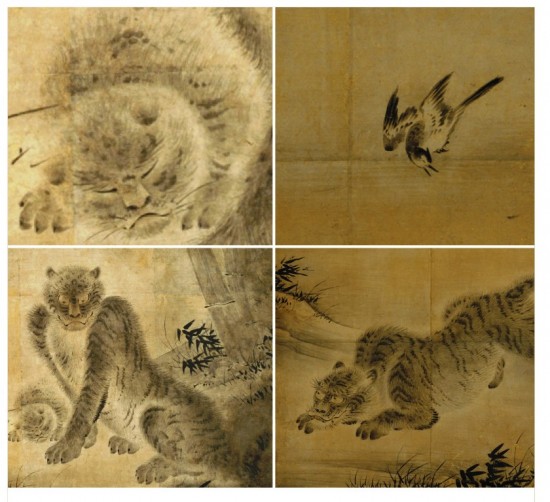[Part I] March 15 (Saturday) – April 23 (Wednesday), 2014
[Part II] April 25 (Friday) – May 28 (Wednesday), 2014
Kankai Pavilion (Traditional East Asian Art)
This exhibition will feature scroll paintings that were once partition paintings (shohekiga) made by artists of the Kano school that decorated the Nikko-in guest hall at Mi’idera (Onjoji) Temple in Shiga prefecture. The businessman Hara Rokuro (1842-1933) acquired the Nikko-in and moved it to his estate in Gotenyama (present-day Kitashinagawa in Shinagawa ward, Tokyo) in 1892. The structure was subsequently donated to Gogokuji temple (in Bunkyo ward, Tokyo) in 1928 where it still stands as the Gekko-den, an Important Cultural Asset. The wall paintings were converted into hanging scrolls and one pair of six-fold screens. These paintings comprise the core of the Hara Rokuro Collection.
The exhibition will be divided into two parts. Assembly at the Orchid Pavilion, which once adorned the Oku no Ma (room) of the Nikko-in, will be featured in Part I, and Tiger in a bamboo grove and Birds and flowers, which once adorned the Shimo no Ma (room), will be displayed in Part II. Designed in the traditional shoin style of Japanese architecture, the Kankai Pavilion provides a viewing experience similar to that of the paintings’ original setting.

Tiger in a bamboo grove (part of paintings used for wallpaper and sliding doors at Nikko-in guest hall in Mi’idera temple) (detail), Kano Eitoku, Momoyama – Edo period [on view from April 25]
[Featured Works]
Traditional Art: [Part I] Scene based on an old Chinese anecdote “Assembly at the Orchid Pavilion”, part of paintings used for wallpaper and sliding doors at Nikko-in guest hall in Mi′idera temple, Kano school, hanging scroll and six hanging scrolls, Momoyama – Edo period /Writing box with scenes from the eight views of Oumi in maki-e, Edo period and others
[Part II] Tiger in a bamboo grove, part of paintings used for wallpaper and sliding doors at Nikko-in guest hall in Mi’idera temple, Kano Eitoku, hanging scroll and four hanging scrolls, Momoyama period / Birds and flowers, part of paintings used for wallpaper and sliding doors at Nikko-in guest hall in Mi’idera temple, attributed to Kano school, four hanging scrolls, Momoyama-Edo period and others
Contemporary Art: Anish Kapoor, Void, 1992 / Yayoi Kusama, “iida Art Editions YAYOI KUSAMA Hand Bag for Space Travel“, 2009 / Yayoi Kusama, “iida Art Editions YAYOI KUSAMA My Doggie Ring-Ring“, 2009 and others
Hara Museum ARC
Address: 2855-1, Kanai, Shibukawa-shi, Gunma 377-0027
Tel 0279-24-6585 Fax 0279-24-0449 E-mail arc@haramuseum.or.jp
http://www.haramuseum.or.jp (official website) http://mobile.haramuseum.or.jp (mobile site)
https://www.art-it.asia/en/u/HaraMuseum_e (blog)http://twitter.com/HaraMuseumARC (Twitter)
Hours: 9:30 am – 4:30 pm (last entry at 4:00 pm)
Closed: Thursdays (except March 27 and May 1)
Admission: General (over 12) 1,100 yen, Students 700 yen (high school and university) or 500yen (elementary and junior high), Free for Hara Museum members; 10% discount for a group of 20 or more; Combination ticket for Hara Museum ARC and Ikaho Green Bokujo (except during Golden Week): General 1,800 yen; Students 1,500 yen (high school and university) or 1,400 yen (junior high), 900 yen (elementary)
Getting There: By train: Take the Joetsu Shinkansen to Takasaki, change to the Joestu Line, and disembark at Shibukawa. From Shibukawa, ARC is 10 minutes away by taxi or 15 minutes by bus (take the Ikaho Onsen bus to “Green Bokujo Mae”). By car: 8 kilometers (about 15 minutes) from the Kan-etsu Expressway Shibukawa Ikaho Interchange (in the direction of Ikaho Onsen)
